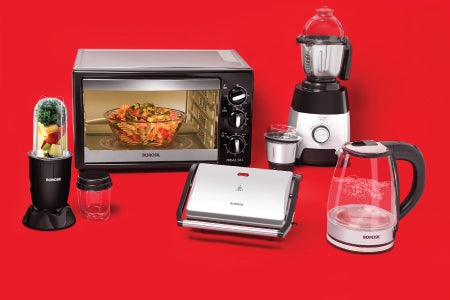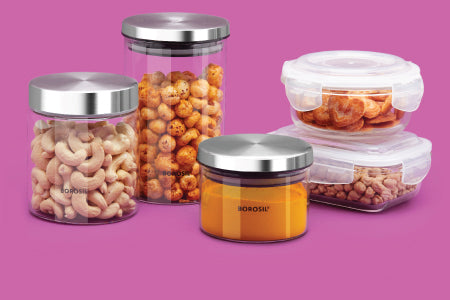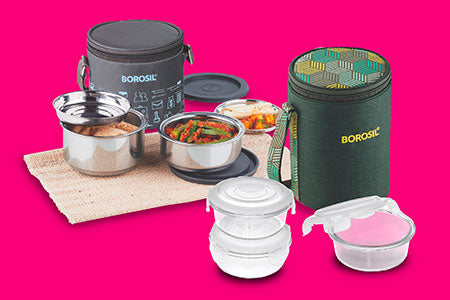
The Beginners Guide to Meal Prepping for the Indian Kitchen
We’ve all been there – tired, bleary eyed, worn-down by office work- standing in the kitchen come mealtime and staring at empty utensils and uncut vegetables, ergo more work. If you’ve had a hard day, the misery is compounded by staring into the cold abyss that is your sparsely stocked fridge. The thought of putting together a meal feels daunting, and that’s putting it mildly. It’s at this juncture that we turn to increasingly familiar habit(s) – instant noodles or ordering in from a familiar restaurant.
But does it have to be this way?
Like all good things, a wholesome, nutrient rich meal starts with a plan or meal prepping. Come to think of it, our mothers did it, so did their mothers and our grandmas’ mothers and so on, with a difference in intent though. Their preparations were geared more towards a particular season; ours are an exercise to cut down time spent in the kitchen, an answer to increasingly cramped schedules. Our mothers and grandmothers ensured spices and grains were laid out in the sun, ground and mixed, ready to be used in the coming season. Pickles and papads were prepared, ready to elevate a simple meal of dal –chawal or khichdi.
Coming back to the present; amidst deadlines and commitments, meal prepping can be quite a handy tool to ensure that cooking is more rejuvenating than plodding. But, there is no one correct method to meal prepping. Like the meals themselves, it’s personal,-defined by habits, family preferences, work schedules and cooking skills. Say, for example-
- If you eat fast food or takeout several nights of the week, your goal may be to choose a specific day of the week to create a food shopping list and hit the grocery store.
- If you already shop for groceries in a planned manner and have basic cooking skills, your goal may be to choose one day a week to do most of the cooking, or try a new recipe.
- If you already cook some weekday meals for your family, you might decide to create a schedule so that you are not deciding at the last minute what to make and to ensure you have the needed ingredients on hand.
Preparations for the prep
If you’ve figured out which one of the above domestic demographic examples you identify with the most, it’s time to move to the next bit- prepping for your meal prep. Now meal prepping for Indian households is unlikely to follow the same pattern as western ones. The nature of our food, the climate we live in and our food habits differ vastly and so it follows that we need to adapt and improvise steps to suit our kitchens. But you could start with a few pointers mentioned below:
- Start a monthly calendar of meal ideas or recipes most requested for, by your family. That way you can keep track of and shop for vegetables and other ingredients most likely to be needed.
- Easy does it when it comes to meal preps. Start small, start simple. First, plan for three days and then work your way towards covering a week.
- Prepare the spice pastes, bhuna masalas, chutneys, and masala mixes in advance. You could opt for store-bought spice powders and pastes too, but if you prefer to use a spice mix that is particular to your family’s kitchen, mix or blitz a batch in advance and store it. Most spice mixes and pastes, if stored in air-tight glass jars, will keep well for a week and some even longer. Borosilicate jars are apt for this as you can use them to store and freeze the masalas in the fridge.
- Even atta for chapatis can be kneaded and stored in the fridge for future use. Just dab the dough with a little oil once it’s been kneaded.
- Dosa batter kept in the freezer will also last for 2-3 weeks. The trick is to divide it into small batches and freeze it. That way you can defrost just the amount you want to use.
- Chopping vegetables every day for every meal can be an arduous task. Most Indian gravies have a base of tomatoes, onions and garlic. Chopping them beforehand and keeping them in glass storage containers that come with air-tight lids will make your work easier when you get down to cooking a meal. Don’t limit your chopping activities to just the ‘Basic Trio’. Fruits like strawberries, mangoes and apples can be diced and stored too.
- Boiled potatoes and eggs also keep for a very long time and come in handy when you want to serve a quick curry.
- Desiccated coconut, a key ingredient in many meals, especially in the south, survives well in the fridge, if stored in air-tight, glass containers.
- If green chillies figure prominently in your recipes, you can store them in your fridge as well. Just remember to take their tops off first.
- Marinated meat cuts, too, can be turned into a meal quite quickly. Just marinate it with your favourite spice mix, put in a storage container, preferably one made of borosilicate glass and pop it into the freezer.
- Stuffed parathas, kebabs, patties and samosas freeze well. The trick is to not cook them all the way through. Just make sure they’re about 75% done, let the food cool, transfer it into air-tight containers and onward to the freezer.
Storage is key
Now that we’ve given you a pretty extensive list to work your way through, let’s talk storage. Refrigeration and freezing are key when it comes to meal planning. You can put in all the effort into chopping, dicing, and blitzing but if the food turns rancid or loses texture and taste, that’s a whole lot of effort gone to waste. It also doesn’t help when you can’t see the stuff you’ve stocked your fridge with. When looking for storage containers, below are a few pointers to keep in mind:
- Go for borosilicate glass storage containers. Always. Apart from the fact they are thermal shock resistant which means you can place your food straight into the microwave from the freezer to thaw, they’re also clear. This helps you to see exactly ‘what’ and ‘how much’ of something you have put away.
- Ensure that the lids are air-tight. This will help to keep the food fresh inside and any smell from pervading…err invading your fridge!
- Most air-tight lids come with a silicone gasket. Check to see if the gasket is removable. If you can remove the silicone gasket, cleaning becomes easier and more thorough.
- Get more of the same (storage containers), in varying sizes. That way, you can stack them up neatly in your fridge and freezer.
Why we think meal prepping is a game changer!
Just in case all the above seemed a little radical, we’ve also listed down (quite succinctly!) why we think the practice ought to become routine rather than an exception.
- Can help save money
- Can ultimately save time
- Can help with weight control, as you decide the ingredients and portions served
- Can contribute to an overall more nutritionally balanced diet
- Can reduce stress as you avoid last minute decisions about what to eat.
Have you tried meal prepping before? Let us know of any unique tips in the comments below!





















